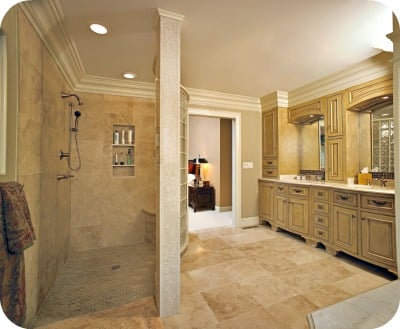Tile design is likely on your checklist of decisions you need to make if you are planning to remodel a bathroom. There are many patterns, materials, shapes and an endless array of colors that you can use. Here are six design ideas for bathroom wall and floor tile from remodeling projects we’ve worked on for Central New York homeowners.
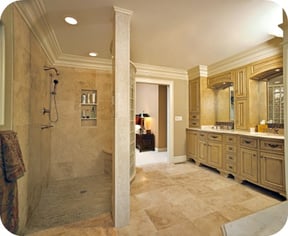
Twelve-inch square travertine tile was used on the floor and walls of this bathroom for easy maintenance. Tile was used to protect the entry to the walk-in shower and to finish the privacy wall. Rectangular 1-by-3-inch mosaic tile was used for the shower floor. 1-by-1-inch brown mosaic tile accents the dual sink vanity and the base of the shower wall.
1. Tile for Function and Style
Tile is an excellent choice for bathroom wall and floor surfaces because it is resistant to water, easy to maintain and available in many attractive styles.
- For easy maintenance consider 12-inch square tile for walls and floors. Less grout means that there are fewer crevices where mildew, soap residue and dirt can build up.
- In the shower, use a smaller tile for traction to help prevent slips and falls. Mosaic or natural stone tile is attractive and practical for shower floors.
- Think about areas in the bathroom near the shower entry and the tub where water may puddle. In these areas wood floor molding may break down and rot over time. Consider using ceramic tile to protect the walls and contain water. Tile used for molding can contrast or blend with floor tile.
- Small mosaic tile adds interest when used as an accent. Linear tile can be used to finish off a field of tile or as an accent to break up the pattern
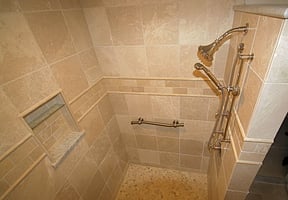
Linear tile breaks up a pattern of 12-by-12-inch and 3-by-6-inch wall tile and frames a wall niche on the interior of this walk-in shower. Stone mosaic tile was used for the shower floor and marble creates a shelf and caps the shower wall.
2. Slip-resistant Floor Tile
Give special consideration to the tile you select for a bathroom floor. There are many shapes, textures, colors and tile products available. While no tile is “slip-proof,” tile with texture can be slip-resistant. Check the manufacturer’s product information to determine if a tile is slip-resistant. Unglazed tile usually provides a good footing, as do many mosaics. Glazed tiles with texture, grit or a wavy profile can also provide adequate traction. Mosaic tile is frequently used on the floor of shower stalls where wet surfaces are especially slippery because of its traction and durability.
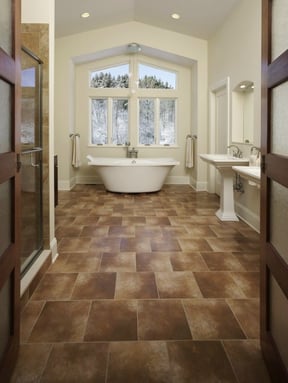
Textured slip-resistant 12-inch tile was used in this bathroom. Note that the tile was also used to frame the entry of the shower.
3. Grid Pattern Tile
One of the most popular tile patterns in bath design is the grid pattern, which uses aligned tile squares to create a field of floor or wall tile. Square tile in different sizes and materials can be used to create contrast and interest in a room. Checkerboard tile is also laid in a grid pattern and created by alternating colors.
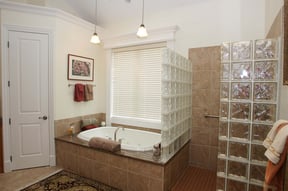
Square tile in a grid pattern used for the tub deck, shower interior and flooring, complements the glass block walls of the walk-in shower.
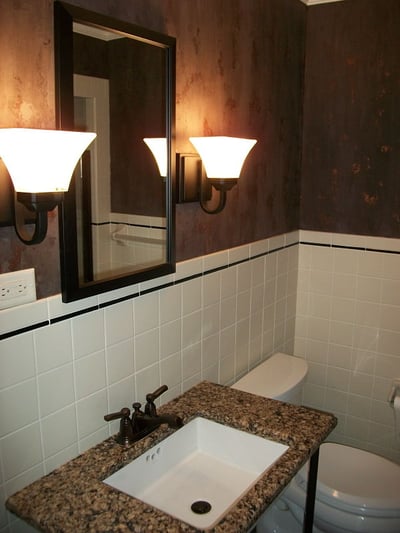
Four-inch square tile was used for the half wall in this powder room. The pattern includes black accent tile and 3-by-6-inch tile as a border for the wall.
4. Subway Pattern Tile
Classic subway or brick pattern tile has stood the test of time. The most common size tile used in bathroom to create this pattern is 3-by-6-inch rectangular tile. Traditional white glazed ceramic tile used on bathroom walls makes a great field for accent tile or can stand on its own.
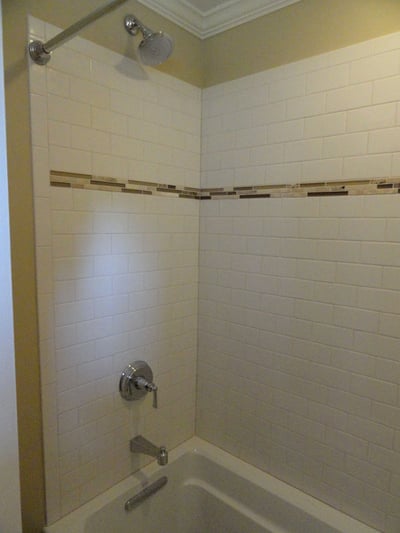
White subway tile was used as a surround for this tub/shower combination with a glass mosaic accent border.
5. Mosaic Tile
Mosaic tile is very versatile. It comes in 12-inch sheets with a mesh backing to simplify installation. As a floor surface, mosaic tile provides traction. It adds color and interest to a bathroom when used as a wall tile or border. Mosaic tile can also be used to accentuate vanities and mirrors.
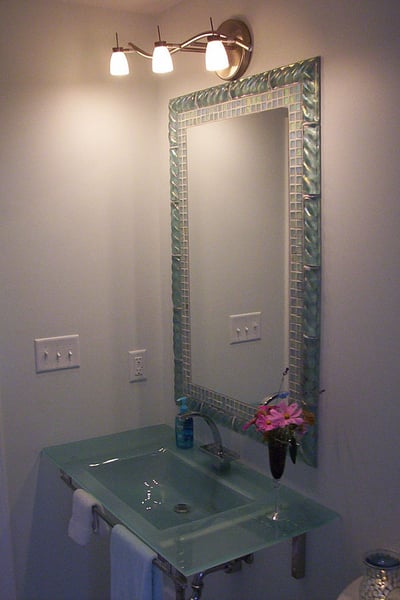
Glass mosaic tile was used to frame the mirror, which creates a focal point in a half bath.
6. Accent Tile
Accent tile can be your personal statement in a bath or kitchen. Colors, shapes and textures reflect elements that you find appealing. We always enjoy planning this aspect of a bath remodeling project with homeowners and including the creative ideas they have for their homes.
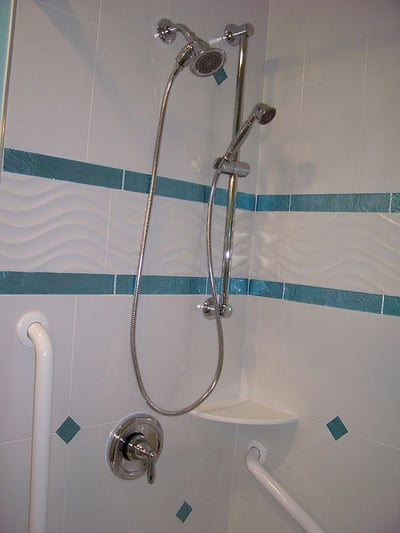
The rippled ceramic tile and bright blue glass accents create an illusion of waves of water in this bath remodel.
